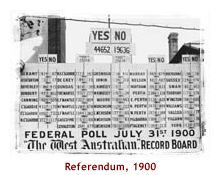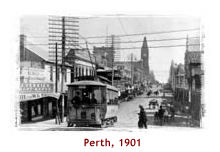| The
reluctant State On 31 July 1900 Western Australia became the final Australian colony to vote for Federation. An overwhelming majority of voters were in favour of union with the eastern colonies. Within six months the Commonwealth of Australia had been proclaimed - 1 January 1901 - and campaigning for Federal elections had begun.  Yet when Western Australians voted in their referendum the outcome of ten
years of Constitutional Conventions and inter colonial wrangling had already
been determined. The new Australian constitution had been proclaimed by
Queen Victoria, omitting reference to Western Australia in the preamble
as it had yet to make up its mind if it would become an original State.
Western Australian political representatives who either opposed Federation
outright or who wanted to hold out for more concessions from the other colonies,
failed completely in their attempts to secure the support of the British
Government. It was clear that Federation would go ahead with or without
Australia's western third.
Yet when Western Australians voted in their referendum the outcome of ten
years of Constitutional Conventions and inter colonial wrangling had already
been determined. The new Australian constitution had been proclaimed by
Queen Victoria, omitting reference to Western Australia in the preamble
as it had yet to make up its mind if it would become an original State.
Western Australian political representatives who either opposed Federation
outright or who wanted to hold out for more concessions from the other colonies,
failed completely in their attempts to secure the support of the British
Government. It was clear that Federation would go ahead with or without
Australia's western third.Sharp divisions in the West had delayed the referendum. These were the result of a decade of dramatic growth, fuelled by the discovery of gold in the colony just a few years after it was granted responsible government in 1890. By the time Western Australia joined the Federation in 1901, its population had soared from under 50,000 to nearly 200,000 in just a decade.  Ideas
about Western Australian and Australian identity
were affected by rapid social changes and economic developments. The arrival
of a wave of immigrants from eastern Australia - referred to as t'othersiders
by Western Australians - coincided with an increased momentum in the other
Australian colonies towards Federation. Met with distrust, disinterest and
hostility by the residents of Western Australia's more established coastal
and farming communities - known as sandgropers - the new arrivals naturally
looked eastwards across the deserts of the interior towards their former
homes. Sandgropers, on the other hand, were more likely to look westwards
across the Indian Ocean towards Britain. The story of Western Australia's
reluctant entry into Federation is the story of these two competing visions. Ideas
about Western Australian and Australian identity
were affected by rapid social changes and economic developments. The arrival
of a wave of immigrants from eastern Australia - referred to as t'othersiders
by Western Australians - coincided with an increased momentum in the other
Australian colonies towards Federation. Met with distrust, disinterest and
hostility by the residents of Western Australia's more established coastal
and farming communities - known as sandgropers - the new arrivals naturally
looked eastwards across the deserts of the interior towards their former
homes. Sandgropers, on the other hand, were more likely to look westwards
across the Indian Ocean towards Britain. The story of Western Australia's
reluctant entry into Federation is the story of these two competing visions. |
Please note: The content on this website is made available for archival purposes and may not meet the State Library of Western Australia's current standards for web accessibility, mobile device compatibility, historical accuracy and cultural sensitivity.